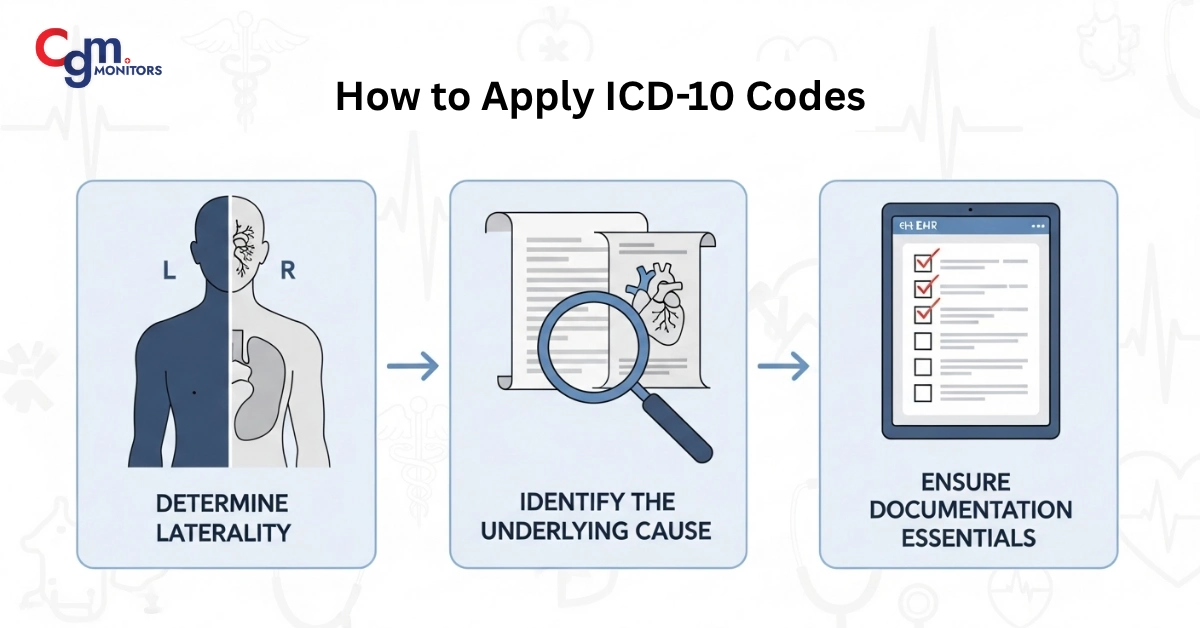Table of content
Chronic lymphedema is more than just swelling—it’s a long-term condition that requires precise documentation, accurate coding, and effective management. If you’re a medical coder, biller, lymphedema therapist, or a patient, understanding the ICD 10 chronic lymphedema codes is crucial for accurate billing and insurance approval. Just like other diseases, Lymphedema also has numerous ICD-10 codes, which help insurance providers differentiate between the condition, such as Q82.0, 189.0, and more. Let’s break it down.
Understanding ICD 10 Codes for Chronic Lymphedema
ICD-10-CM codes are the standard for documenting diseases and health conditions in the United States. For chronic lymphedema, accurate coding ensures:
- Proper insurance reimbursement
- Clear communication between doctors, therapists, and coders
- Tracking disease severity and laterality
Some of the ICD-10 codes for lymphedema include:
| ICD-10 Code | Description | Typical Use Case |
| I89.0 (billable) | Non-infective disorders of lymph nodes & lymphatic vessels: Lymphedema, not elsewhere classified | Most adult-onset or secondary lymphedema cases |
| Q82.0 (billable) | Hereditary lymphedema | Congenital (inherited – subtype of primary lymphedema) or primary lymphedema, often diagnosed in children |
| I97.2 (billable) | Postmastectomy (after removal of breast tissues) lymphedema syndrome | Lymphedema occurring during a surgery or afterward |
- I89.0 (Lymphedema, not elsewhere classified) is part of the I89 category, which also includes I89.1, I89.8, and I89.9.
- Q82.0 (Hereditary lymphedema) is part of the Q82 category, which also includes other specified congenital malformations of skin, such as Q82.1, Q82.2, Q82.3, Q82.4, Q82.5, Q82.6, Q82.8, and Q82.9.
- I97.2 (Postprocedural cardiac insufficiency) is part of the I97 category, which also includes other postprocedural disorders of the circulatory system, such as I97.0, I97.1, I97.8, and I97.9.
Tip: Always check whether lymphedema is primary (Q82.0) or secondary (I89.0). Misclassification can lead to claim denials.
How to Apply ICD 10 Codes
When coding chronic lymphedema, consider:
1. Laterality – Is it unilateral or bilateral lower extremities?
- I89.0 with bilateral modifier may be used.
- ICD 10 code for lymphedema bilateral lower extremities is documented in I89.0 (with additional notes in EHR).
2. Underlying cause – For secondary lymphedema, include:
- Thymus disease
- Nephrotic syndrome
- Peripheral neuropathy
3. Documentation essentials – Your doctor should note:
- Onset and duration
- Location (left, right, bilateral)
- Cause or risk factors
- Any prior therapies
Documentation matters: Missing laterality or cause can delay reimbursement.
Is medical billing making your practice hectic? Medical billing companies, like HelloMDs, are already helping numerous practices across USA and your clinic may be the next.

Coding Comparison: I89.0 vs Q82.0
The following table helps select I89.0 or Q82.0:
| Feature | I89.0 | Q82.0 |
| Onset | Usually adult, secondary | Congenital or hereditary |
| Cause | Infection, surgery, trauma | Genetic mutations |
| Documentation | Must include cause and affected limb | Usually noted at birth or early childhood |
| Billing Tip | CPT codes may vary based on therapy | Often bundled with genetic evaluation |
Use I89.0 for most adult patients, and Q82.0 only for congenital or hereditary cases.
Case Studies by Hello MDs: Real-World Coding Scenarios
- Patient A: 55-year-old female, post-mastectomy, swelling in right arm.
-Code: I89.0 + CPT for lymphedema therapy - Patient B: 12-year-old male, congenital lymphedema.
-Code: Q82.0 - Patient C: Adult with bilateral lower extremity swelling due to nephrotic syndrome.
-Code: I89.0 (bilateral) + N04.x for nephrotic syndrome
Case studies help clarify tricky coding situations, especially when secondary conditions are present.
Experiencing circulatory or lymphatic disorders?
A portable pneumatic compression device, such as BioCompression, may help. Check out your eligibility with CGM Monitors now.
Navigating the 2025 ICD-10-CM Changes for Lymphedema
- Minor revisions in the descriptors of lymphedema laterality
- Updates to hereditary vs. secondary distinctions
- Emphasis on documenting chronic inflammation or neuropathy causes
Staying updated ensures maximum reimbursement and avoids claim denials.
Billing Tips for Therapists
- Use correct CPT codes for manual lymphatic drainage or compression therapy
- Document treatment frequency and duration
- Pair ICD 10 code for chronic lymphedema with CPT codes to support reimbursement
- Track patient progress for audits and insurance verification
Conclusion:
There are multiple ICD 10 chronic lymphedema codes, among which some have been explained in this blog. Accurate ICD 10 coding ensures your patients get the right care, therapists receive reimbursement, and your clinic avoids claim issues. Keep your documentation precise, and update yourself with the 2025 ICD-10 changes. In case you experience trouble or simply want to offload your administrative tasks, a medical billing company may be the solution, example of which has also been shared above.
Frequently Asked Questions
What causes neuropathy?
Multiple sclerosis (an autoimmune disease harming the covering of nerve cells), brain injuries, strokes (brain attack), and some other health conditions can lead to neuropathy (nerve damage or disorder).
What is nephrotic syndrome?
A kidney disorder harming the blood vessels in the kidney, leading to too much protein in urine. Symptoms include foamy urine, severe swelling, a sick feeling, weight gain, and loss of appetite.
What is chronic inflammation?
Long-term inflammation that lasts up to weeks, months, or even years is known as chronic inflammation. There are multiple diseases due to which your immune system can become overactive.
Disclaimer: This blog is for informational purposes only and does not constitute medical, legal, or professional advice. While we strive for accuracy, errors or omissions may occur.







Write a comment
Your email address will not be published. All fields are required